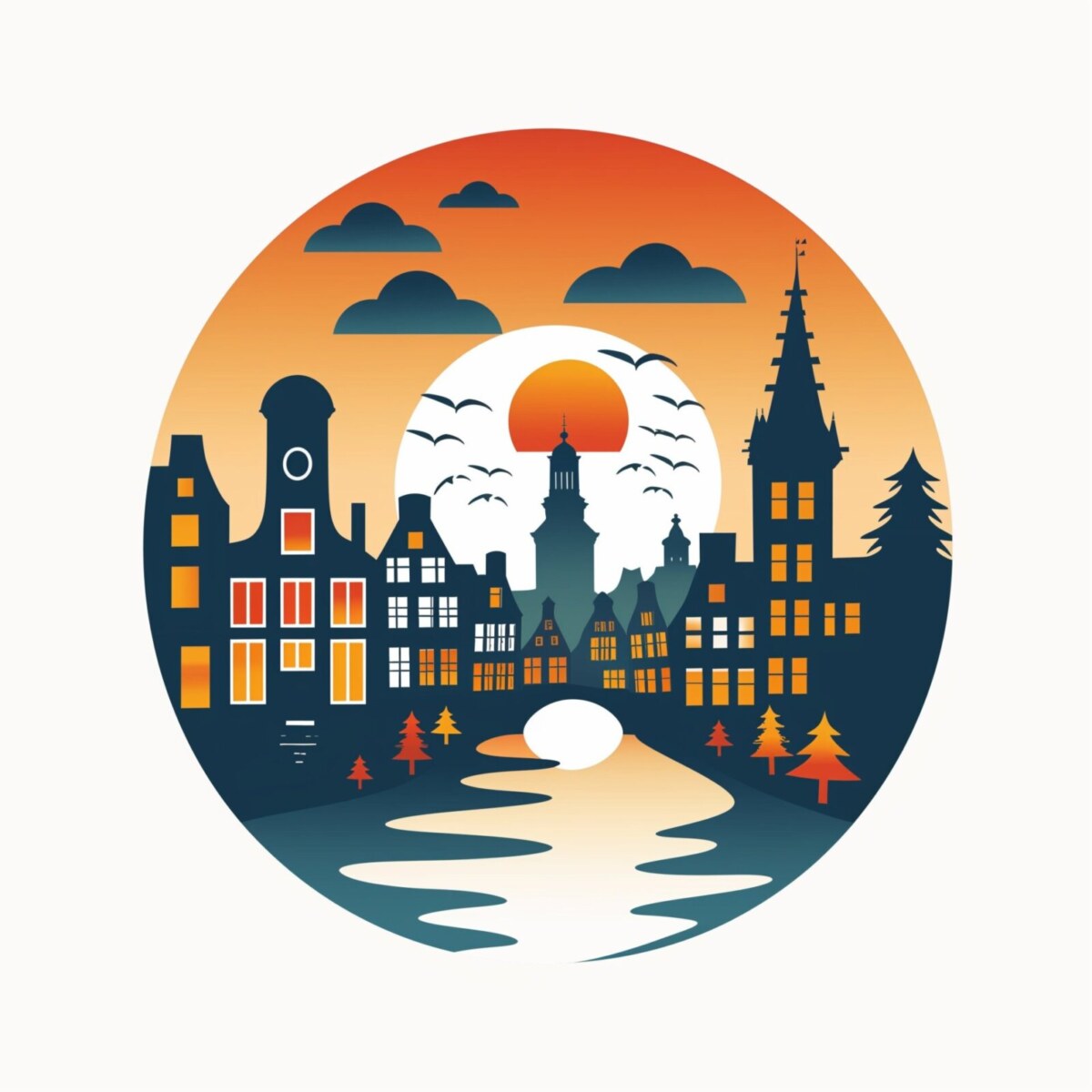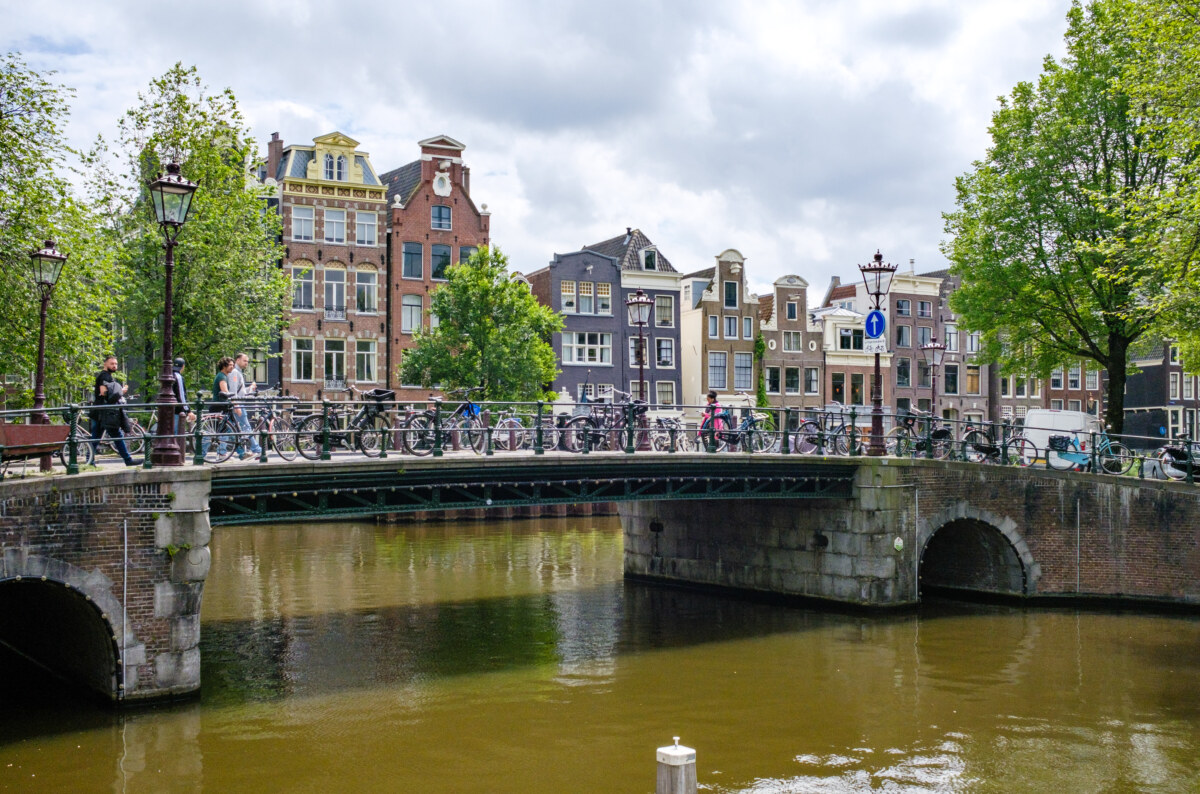Amsterdam’s iconic canal system is a masterpiece of 17th-century Dutch Golden Age urban planning and is now recognized as a UNESCO World Heritage site. Amsterdam’s intricate network of waterways weaves through the city like liquid history, telling stories of trade, wealth, and ingenious Dutch water management. With over 100 kilometers of canals, 1,500 bridges, and 165 waterways (more than Venice), Amsterdam has earned its nickname as the “Venice of the North.”
Created primarily during the Dutch Golden Age in the 17th century, Amsterdam’s canal ring (Grachtengordel) represents one of history’s most ambitious urban planning projects. The concentric semicircular design solved practical transportation and water management challenges and created a harmonious cityscape that continues to captivate visitors four centuries later.
In 2010, UNESCO recognized Amsterdam’s canal district as a World Heritage site, acknowledging its “outstanding universal value” as a masterpiece of urban planning. These historic waterways remain the beating heart of the Netherlands’ capital, lined with narrow gabled houses, museums, cafés, and the distinctive houseboats that have become synonymous with Amsterdam living. The Canal Ring’s distinctive half-moon pattern was designed in the early 17th century as part of Amsterdam’s urban expansion plan.
The 15 Most Beautiful Canals in Amsterdam
1. Herengracht (Gentlemen’s Canal)
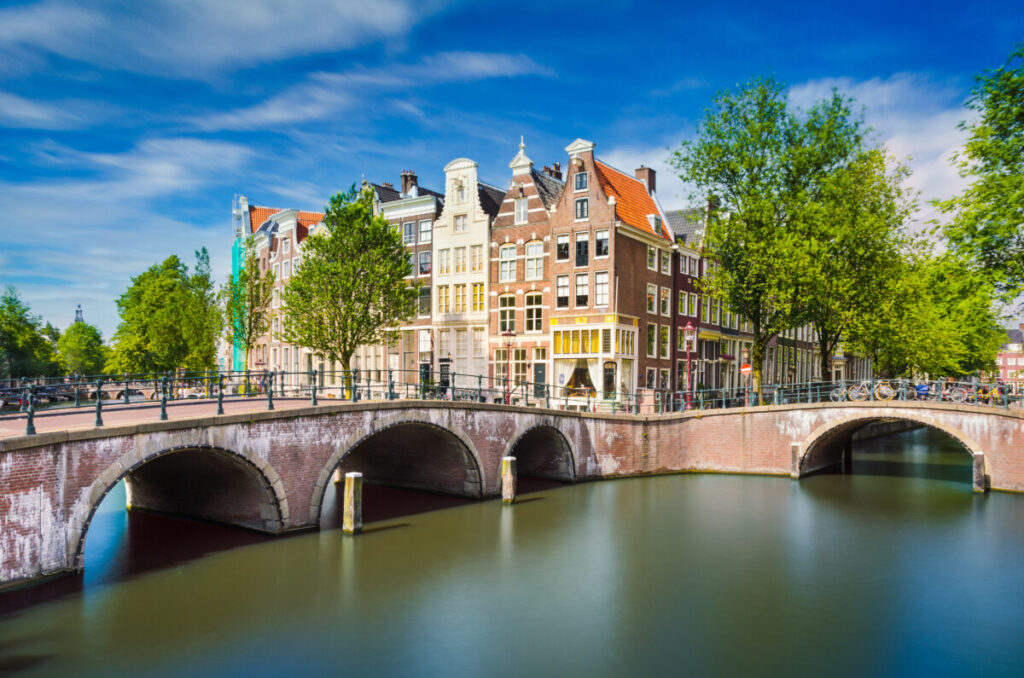
The prestigious Golden Bend section of Herengracht features some of Amsterdam’s most opulent merchant mansions built during the Golden Age.
- Location: Central Canal Belt
- Built: 1612-1613
- Named after: The “gentlemen” (heren) of the city government
Herengracht is the most prestigious of Amsterdam’s main canals, forming an essential part of the UNESCO-protected canal ring. This elegant waterway was designed for Amsterdam’s wealthiest citizens, with its most exclusive section—the “Golden Bend” (Gouden Bocht)—showcasing the immense prosperity of 17th-century Dutch merchants.
Walking along Herengracht reveals a parade of stately canal houses with elaborate gabled facades mirrored in the tranquil water. During springtime, the canal’s tree-lined banks burst with green leaves and occasional blooms, creating one of Amsterdam’s most picturesque settings.
Many of the grand mansions along Herengracht now house museums and cultural institutions. Don’t miss the Museum of the Canals (Het Grachtenhuis) at Herengracht 386, which tells the fascinating story of Amsterdam’s canal system through interactive exhibits.
Must-See Spots:
- The Golden Bend between Leidsestraat and Vijzelstraat
- Het Grachtenhuis (Museum of the Canals)
- Bartolotti House at Herengracht 170-172, with its curved facade
- The Cat Cabinet Museum at Herengracht 497
2. Prinsengracht (Prince’s Canal)
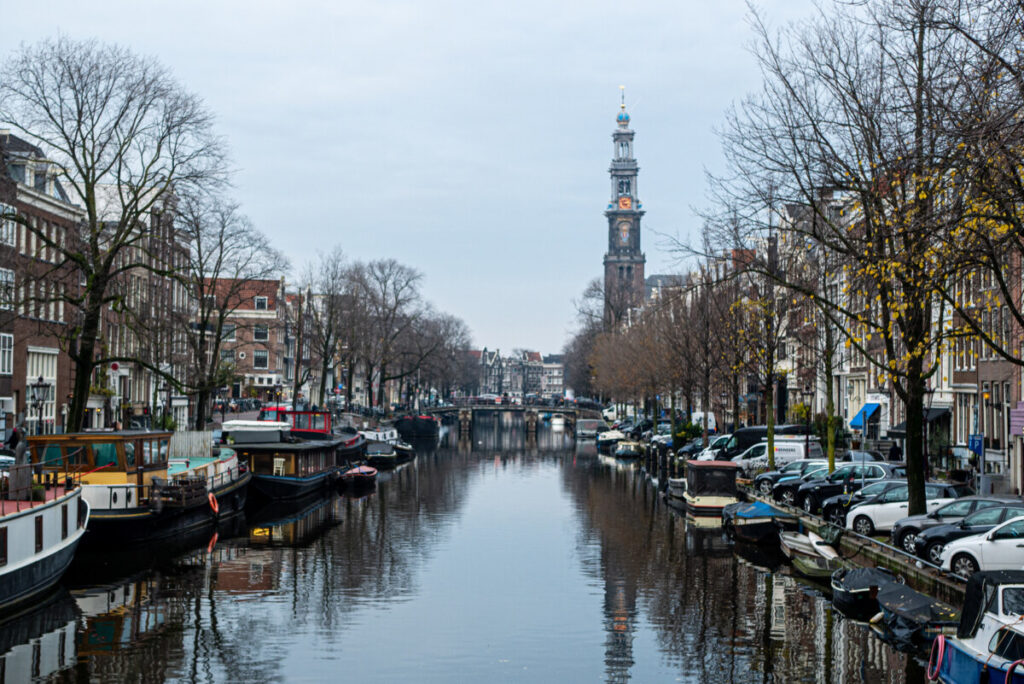
- Location: Outer ring of the Canal Belt, borders Jordaan district
- Built: 1612-1620
- Named after: The Prince of Orange, William I, leader of the Dutch Revolt
Prinsengracht loops magnificently through the city center and the bohemian Jordaan district as Amsterdam’s longest canal. This lively waterway hosts many of Amsterdam’s most significant landmarks, including the Anne Frank House and the soaring Westerkerk church with its iconic blue spire that dominates the skyline.
Prinsengracht offers perhaps the most authentic glimpse into Amsterdam’s daily life: colorful houseboats bob alongside centuries-old canal houses. At the same time, the vibrant atmosphere of the Jordaan’s markets and cafés spills toward the water’s edge. During annual celebrations like King’s Day (April 27) and Canal Pride (August), Prinsengracht transforms into the epicenter of citywide festivities.
The Noordermarkt at the intersection with Brouwersgracht hosts popular Saturday markets, including an organic farmers’ market and a textile market, making this area especially lively on weekends.
Must-See Spots:
- Anne Frank House (Prinsengracht 263-267)
- Westerkerk church with its 85-meter tower
- Houseboat Museum at Prinsengracht 296
- Noordermarkt (Saturday markets)
- Amstelveld square with the Amstelkerk
3. Keizersgracht (Emperor’s Canal)

- Location: Middle canal of the three main canals
- Built: 1612-1615
- Named after: Holy Roman Emperor Maximilian I
- Width: 28 meters (the widest of the main canals)
Named after Holy Roman Emperor Maximilian I, Keizersgracht is the widest canal in Amsterdam’s central belt, at an impressive 28 meters across. When constructed in the 17th century, this majestic “Emperor’s Canal” was designed to be the most prominent of the three main canals, reflecting its imperial namesake.
Keizersgracht is lined with especially grand merchant houses and notable buildings like Museum Van Loon, which offers visitors the chance to enter a fully restored canal mansion with a coach house and garden. The canal is slightly quieter than neighboring Herengracht and Prinsengracht, providing a more peaceful atmosphere for a leisurely walk.
With its neoclassical facade, the Felix Meritis building at Keizersgracht 324 has been an important cultural center since 1788. After extensive renovation, it hosts concerts, debates, and other cultural events.
Must-See Spots:
- Museum Van Loon at Keizersgracht 672
- Felix Meritis Cultural Center
- The Homomonument near the Westerkerk
- The narrowest house in Amsterdam at Keizersgracht 187 (just 2.02 meters wide)
4. Singel (Old City Moat)
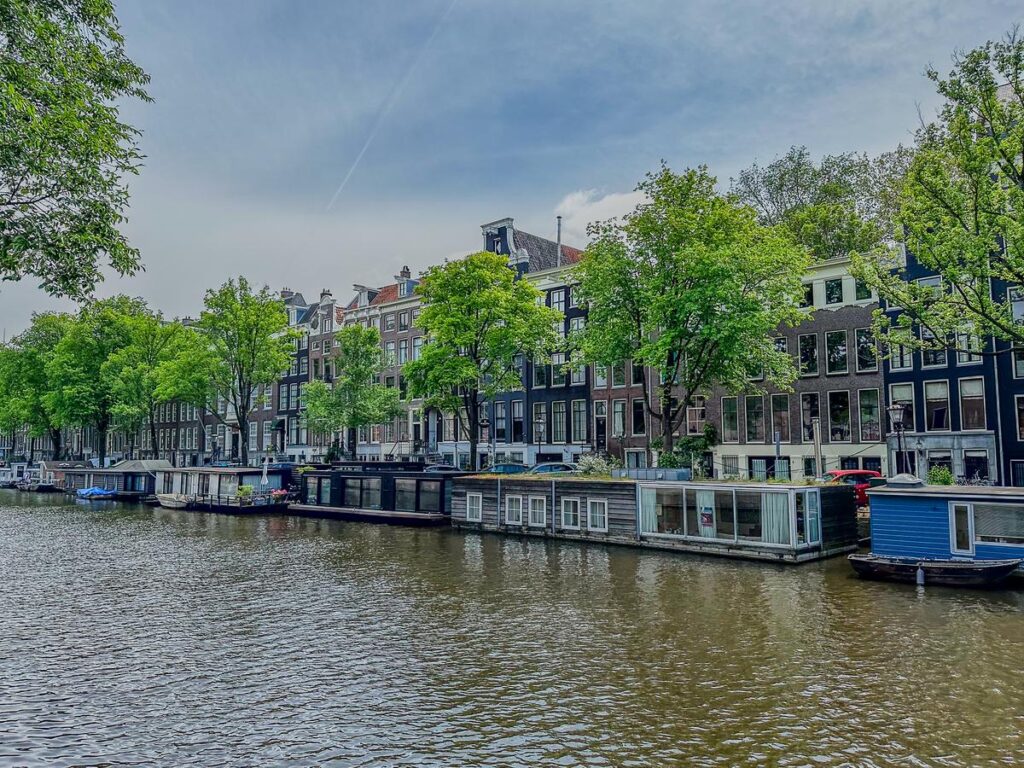
- Location: Encircles the medieval center of Amsterdam
- Built: Early 15th century
- Original purpose: City moat and defensive water barrier
The Singel holds the distinction of being Amsterdam’s oldest canal, originally dug in the medieval period as a moat to defend the walled city. This curved waterway encircles Amsterdam’s historic center today, marking where the city’s defensive boundary once stood centuries ago.
Visitors to the Singel will discover the world-famous floating flower market (Bloemenmarkt), the only one of its kind, where colorful flowers and Dutch bulbs have been sold from floating barges since 1862. The canal is also home to Amsterdam’s narrowest house, measuring just over two meters wide.
Between Singel 140-142, you can spot “Het Kleine Trippenhuis” (The Small Trippenhouse). According to legend, it was built by the carriage driver of the wealthy Trip brothers, who supposedly said he wanted a house “as wide as his masters’ door.” While likely apocryphal, the story adds to the charm of this historic waterway.
Must-See Spots:
- Bloemenmarkt (floating flower market)
- Amsterdam’s narrowest house at Singel 7
- The Old Lutheran Church (Oude Lutherse Kerk)
- Roundhouse (Ronde Lutherse Kerk) at Singel 11
- Central Library (former Koopmansbeurs/Beurs van Berlage)
5. Brouwersgracht (Brewers’ Canal)

- Location: Junction of the Jordaan and the Canal Belt
- Built: Early 17th century
- Named after: The numerous breweries once located along its banks
Often voted Amsterdam’s most beautiful canal, Brouwersgracht (“Brewers’ Canal”) was once the industrial heart of the city’s beer production. During the 17th century, this canal was lined with breweries and warehouses, their wide doors and hoisting beams designed for moving goods between boats and storage.
Today, these former warehouses have been transformed into some of Amsterdam’s most coveted residences. Still, the canal retains its postcard-perfect charm with arched bridges, tree-shaded quays, and flower-adorned houseboats. The distinctive warehouse buildings can be identified by their large windows and spacious lofts where goods were once stored.
At the intersection with Prinsengracht stands Café Papeneiland, which serves Dutch apple pie in a 400-year-old building. Local legend claims that even Bill Clinton couldn’t resist their apple pie during a presidential visit.
Must-See Spots:
- Junction with Herengracht, Keizersgracht, and Prinsengracht (Four Canals Corner)
- Café Papeneiland at the corner with Prinsengracht
- Former warehouses with names still visible on facades
- Houseboats decorated with flowering plants
6. Reguliersgracht (Seven Bridges)

- Location: Eastern Canal Belt
- Built: 1658
- Named after: The Reguliersklooster, a monastery that once stood nearby
Though modest in length, Reguliersgracht offers one of Amsterdam’s most magical vistas: the famous “Seven Bridges” view. At its intersection with Herengracht, visitors can see seven consecutive bridges perfectly aligned in a row—a perspective that becomes enchanting at night when the bridge arches are illuminated.
This narrow, peaceful canal cuts through the eastern part of the Canal Belt, lined with quaint houses adorned with traditional gables and flower boxes. Its photogenic quality and romantic atmosphere have made it a favorite spot for locals and photographers, appearing on countless postcards and Instagram feeds.
Despite being just steps away from busier areas, Reguliersgracht maintains a tranquil charm that exemplifies the quieter side of Amsterdam’s canal system. The small bridges crossing the canal are perfect spots for watching boats glide by or simply soaking in the timeless atmosphere.
Must-See Spots:
- The Seven Bridges view from the Herengracht intersection
- Historic residential buildings with traditional gabled roofs
- Picturesque corners where local artists often set up easels
- Illuminated bridges at night
7. Bloemgracht (Flower Canal)
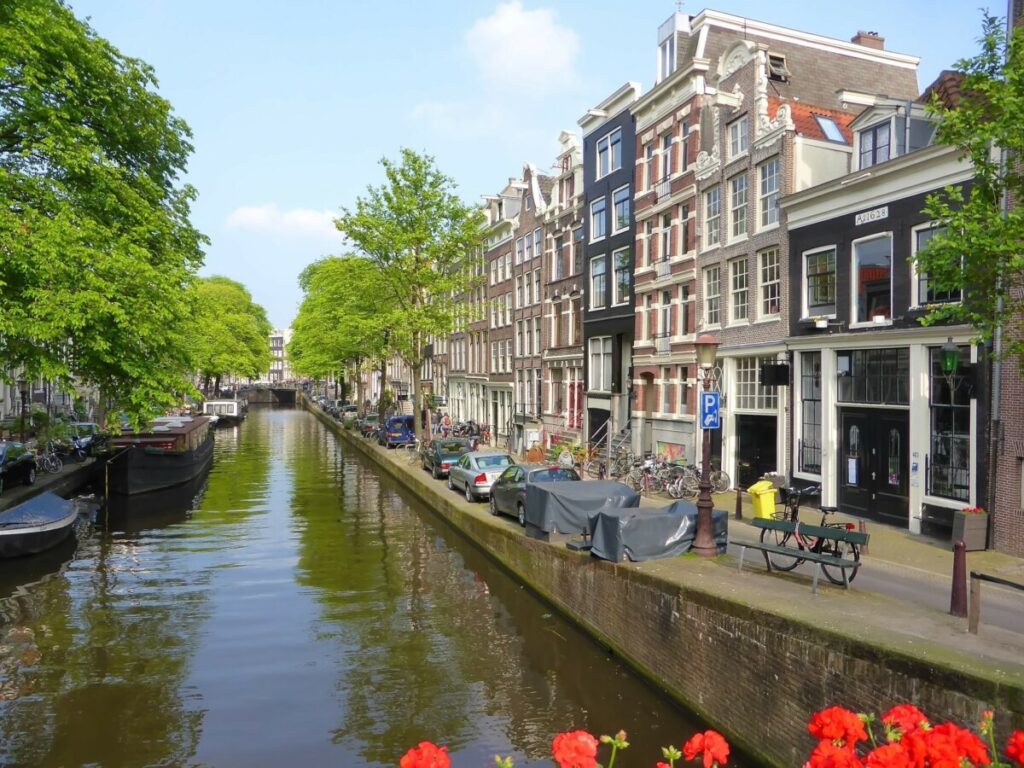
- Location: Jordaan district
- Built: Early 17th century
- Named after: The flowers that were once traded here on floating barges
Located in the bohemian Jordaan district, Bloemgracht (“Flower Canal”) was once home to a floating flower market where barges laden with blooms would dock. While the flower barges are gone, this tranquil waterway is still considered one of the Jordaan’s most beautiful canals, offering a glimpse into the neighborhood’s artistic heritage.
Rows of narrow 17th-century houses with decorative gables line its banks, and hidden behind many buildings are hofjes (small enclosed courtyards)—peaceful refuges from city life. Historically, the canal attracted many artists and craftsmen, and this creative legacy continues today with small galleries and studios.
With fewer tourists than the main canals, Bloemgracht provides an authentic Amsterdam experience along a waterway that feels like a local secret. The canal is particularly beautiful in spring when residents decorate their windowsills and balconies with colorful blooms.
Must-See Spots:
- Traditional narrow houses with decorative gables
- Hidden hofjes (courtyard gardens) behind the street facades
- Former warehouses converted to residential lofts
- Small art galleries showcasing local talent
8. Egelantiersgracht (Eglantine Canal)
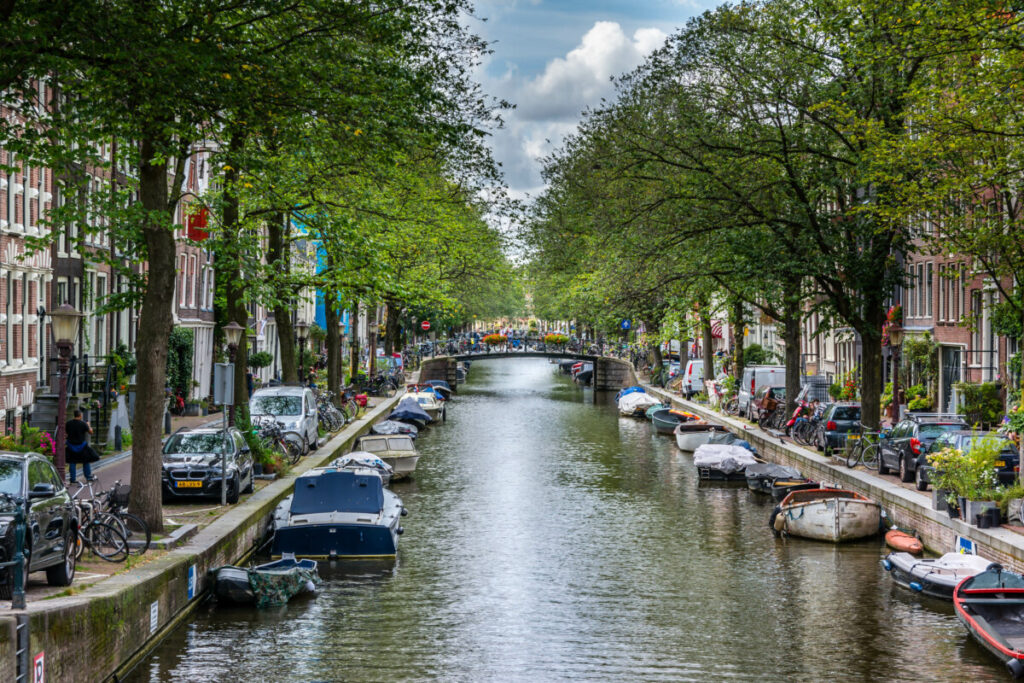
- Location: Jordaan district
- Built: Early 17th century
- Named after: The eglantine (wild rose)
Named after the eglantine (wild rose), Egelantiersgracht is another charming canal winding through the Jordaan district. From the early 17th century, this peaceful stretch of water represents the more residential and authentic side of Amsterdam’s canal system.
Small bridges cross the calm water, and in summer, flowers adorn the houseboats and canal banks. A highlight along Egelantiersgracht is Café ‘t Smalle, a beloved pub housed in an 18th-century distillery owned by the Hoppe family. Its waterside terrace offers one of the most pleasant spots in Amsterdam to enjoy a Dutch beer while watching boats glide by.
The scene here feels remarkably unchanged over time—locals still sit on stoops or cycle over the bridges—offering visitors an authentic Amsterdam experience away from the tourist crowds. The canal is also home to several small specialty shops and artisan workshops, continuing the neighborhood’s tradition of craftsmanship.
Must-See Spots:
- Café ‘t Small,e with its waterside terrace
- The Johnny Jordaanplein with sculptures honoring local folk singers
- Historic residential buildings with preserved original features
- Small specialty shops and artisanal workshops
See Related: Amsterdam Canal Swimming Spots: Top Must-Visit Locations
9. Oudezijds Voorburgwal (Old Side Front Rampart)
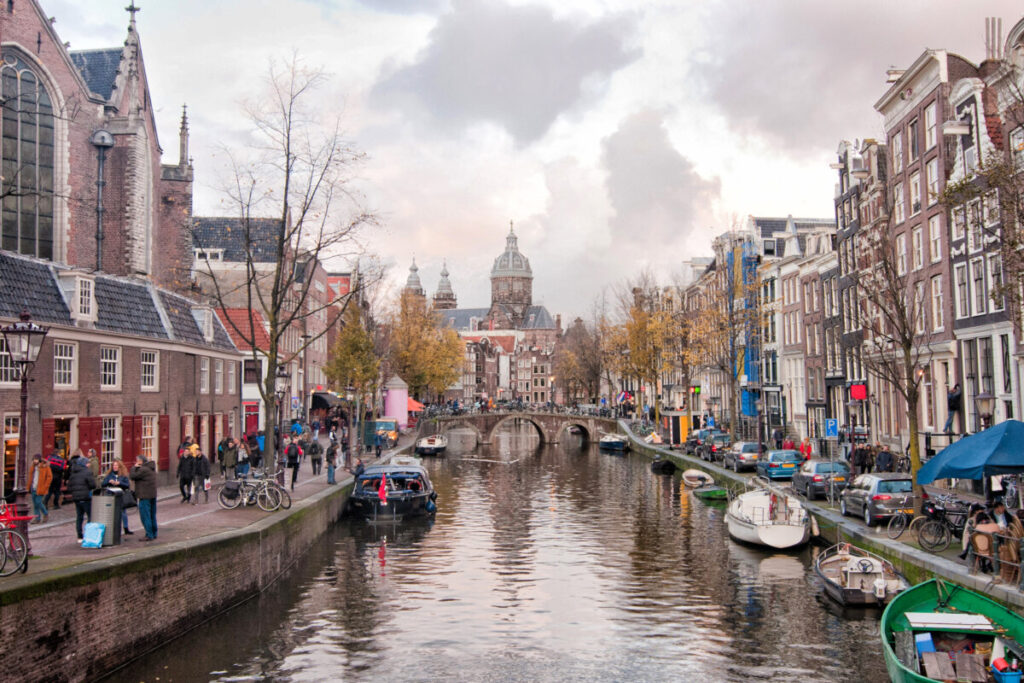
- Location: De Wallen (Red Light District)
- Built: Late 14th century
- Distinction: Amsterdam’s oldest canal
Oudezijds Voorburgwal is Amsterdam’s oldest canal, dating back to the late 14th century. It flows through the city’s medieval heart in an area now known as De Wallen (the Red Light District). This historic waterway reveals Amsterdam’s fascinating blend of old and new, sacred and profane.
The Oude Kerk (Old Church), along its banks, is Amsterdam’s oldest building. Its Gothic architecture starkly contrasts the area’s notorious red-lit windows. By day, visitors can admire centuries-old brick warehouses and gabled facades reflected in the canal waters. By night, red neon lights create shimmering reflections on the surface.
Despite its location in the Red Light District, Oudezijds Voorburgwal is rich in history and architectural treasures. The Agnietenkapel, a 15th-century chapel that housed one of Amsterdam’s earliest higher education institutions, still stands along this ancient waterway.
Must-See Spots:
- Oude Kerk (Old Church), Amsterdam’s oldest building
- Bridge 213 near Zeedijk with views of traditional gabled houses
- Agnietenkapel, a 15th-century chapel
- Museum Our Lord in the Attic, a hidden 17th-century church
10. Zwanenburgwal (Swan Castle Rampart)
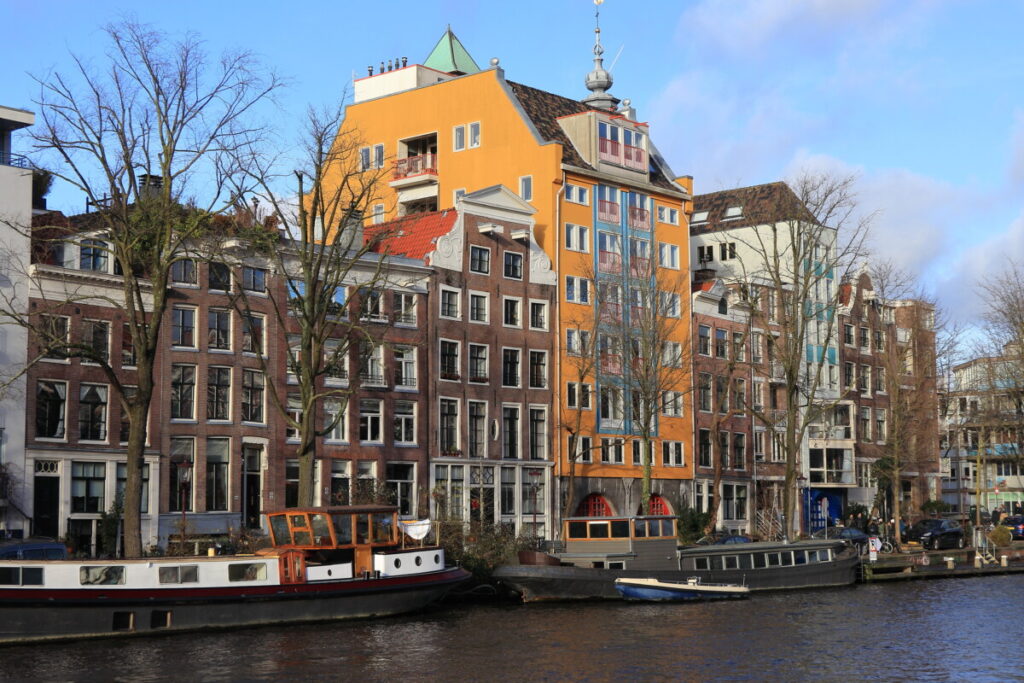
- Location: Connects Waterlooplein to the Amstel River
- Built: Medieval period, expanded in the 17th century
- Former name: Verversgracht (Dyers’ Canal)
Once known as the “Dyers’ Canal,” where textile workers would hang their freshly dyed fabrics to dry, Zwanenburgwal became one of Amsterdam’s most charming waterways. This canal boasts an impressive artistic and intellectual heritage—Rembrandt van Rijn and philosopher Baruch Spinoza once called it home.
Today, Zwanenburgwal connects the Waterlooplein market area with the Amstel River and was voted one of Amsterdam’s most beautiful streets by city residents in 2006. A statue of Spinoza stands near City Hall, marking the philosopher’s historical presence.
The neighborhood surrounding Zwanenburgwal has deep connections to Amsterdam’s Jewish heritage, as it bordered the former Jewish quarter before World War II. For those interested in Amsterdam’s cultural history, this peaceful canal offers a contemplative walk through several layers of the city’s rich past.
Must-See Spots:
- Spinoza statue near the Stopera (City Hall/Opera House)
- Moses and Aaron Church
- The former site of Rembrandt’s house at Zwanenburgwal 8
- Waterlooplein flea market nearby
11. Groenburgwal (Green Castle Rampart)

- Location: Old Center
- Built: Medieval period
- Named after: A “green castle” or fortification that once stood nearby
Small but spectacularly photogenic, Groenburgwal offers what many consider one of Amsterdam’s most iconic views: the slender tower of the Zuiderkerk (South Church) perfectly framed at the canal’s end—a scene famously captured by Claude Monet during his visit to Amsterdam in 1874.
This tranquil canal in the old center is lined with well-preserved 17th-century warehouses and quaint houses that seem untouched by time. A small humpback bridge crossing Groenburgwal has become a favorite spot for photographers seeking to capture the church spire reflected in the water below.
Hidden away from the busier tourist routes, Groenburgwal provides a peaceful moment among Amsterdam’s waterways and one of the city’s most postcard-worthy settings. The area around the canal was once home to many artisans and craftspeople, and some traditional workshops still operate in the neighborhood.
Must-See Spots:
- View of the Zuiderkerk Tower from the canal
- The small humpback bridge (perfect for photos)
- Historic warehouses with original hoisting beams
- Staalstraat Bridge connecting to Kloveniersburgwal
12. Kloveniersburgwal (Crossbowmen’s Canal)

- Location: Eastern Old Center
- Built: Middle Ages, expanded in the 16th-17th centuries
- Named after: The kloveniers, civic guards armed with primitive rifles
Kloveniersburgwal takes its name from the kloveniers, the civic guards armed with primitive rifles who helped defend Amsterdam in the 17th century. Their former headquarters, the Kloveniersdoelen, once stood along this canal—a building where Rembrandt’s famous “Night Watch” was first displayed in 1642.
Today, stately canal houses line this historic waterway, including the notable Trippenhuis with its unusually broad façade, now home to the Royal Netherlands Academy of Arts and Sciences. The Trippenhuis was built for the wealthy Trip brothers, who made their fortune in the arms trade, and legend has it that the width of its front door could accommodate a carriage with four horses.
Kloveniersburgwal runs from the Nieuwmarkt area down to the Amstel River, passing the University of Amsterdam along the way. Despite its central location, the atmosphere along this canal remains surprisingly tranquil, offering visitors a chance to trace Amsterdam’s civic history while enjoying a quieter stretch of the old city.
Must-See Spots:
- Trippenhuis at Kloveniersburgwal 29
- The site of the former Kloveniersdoelen (now the Doelen Hotel)
- The University of Amsterdam’s historic buildings
- Staalmeestersbrug bridge connecting to the Groenburgwal
13. Oudeschans (Old Rampart)

- Location: Eastern edge of the old city center
- Built: 16th century
- Original purpose: Part of the city’s defensive moat
Oudeschans (“Old Trench”) is a broad canal that recalls Amsterdam’s maritime past, having once formed part of the city’s defensive moat. Along its eastern bank stands the distinctive Montelbaanstoren, a guard tower built in 1512 and later crowned with a clock spire in 1606 that earned the nickname “Malle Jaap” (“Silly Jack”) for its once unreliable bells.
Today, this ivy-clad tower watches over a tranquil scene of houseboats and converted warehouses. Unlike the busy canals of the center, Oudeschans offers a more spacious feeling with wider views across the water. The area has a distinctly maritime character, with the National Maritime Museum and old harbor districts nearby.
The Oudeschans neighborhood became home to many Portuguese-Jewish refugees in the 17th century, contributing to Amsterdam’s reputation for religious tolerance. For visitors seeking a sense of Amsterdam’s connection to the sea without the tourist crowds, Oudeschans provides an atmospheric canal walk rich in naval history.
Must-See Spots:
- Montelbaanstoren (Montelbaanstower)
- Former warehouses of the Dutch East India Company
- Converted warehouses now house apartments and businesses
- Views toward the NEMO Science Museum and the Maritime Museum
14. Spiegelgracht (Mirror Canal)

- Location: Connects the Canal Belt to the Museum Quarter
- Built: 17th century
- Named after: Possibly the clear, mirror-like water or the many glass artisans once working here
Though short in length, Spiegelgracht connects the Canal Belt to the Museum Quarter and is renowned for its concentration of art and antique dealers. This small canal traverses the Spiegelkwartier (Mirror Quarter), Amsterdam’s premier district for art galleries and specialty shops selling everything from Rembrandt etchings to Delft pottery.
Walking along Spiegelgracht offers a visual feast for art lovers, with gallery windows displaying old and new treasures. The canal also provides one of Amsterdam’s most interesting urban perspectives: looking one way reveals rows of classic canal houses and art storefronts, while looking the other offers a glimpse of the Rijksmuseum’s magnificent towers.
Art has flourished here since the Rijksmuseum opened in 1885, attracting dealers and collectors who established businesses nearby. With several cafés along its route, Spiegelgracht is perfect for combining cultural browsing with a relaxing break by the water.
Must-See Spots:
- Numerous art galleries and antique shops
- View of the Rijksmuseum from the canal
- Traditional canal houses with shops at street level
- Specialty stores selling maps, prints, and Dutch artifacts
15. Nieuwe Herengracht (New Gentlemen’s Canal)
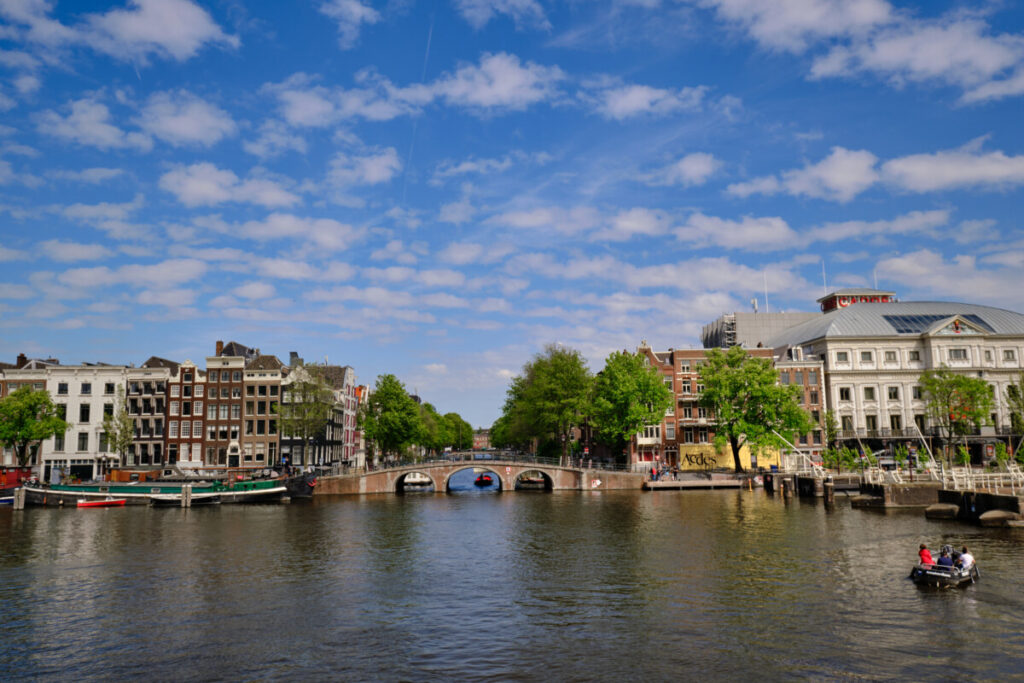
- Location: Plantage district
- Built: Late 17th century
- Named after: Extension of the Herengracht into the eastern city
Nieuwe Herengracht extends the elegance of Herengracht into the leafy Plantage district, an area developed in the late 17th century as Amsterdam expanded eastward. This “New Gentlemen’s Canal” became home to affluent residents and learned institutions, creating a refined atmosphere that persists today.
The canal’s most famous neighbor is the Hortus Botanicus, Amsterdam’s centuries-old botanical garden where rare plants from Dutch trading expeditions were once cultivated. A walk down Nieuwe Herengracht reveals small drawbridges, dignified residences, and a tranquil scene far removed from downtown’s bustle.
The canal is also steps away from the Hermitage Amsterdam museum and the Portuguese Synagogue, reflecting the area’s rich cultural heritage. In the 18th century, the eastern end of Nieuwe Herengracht became home to wealthy Jewish families, making it an important site in Amsterdam’s Jewish history.
Must-See Spots:
- Hortus Botanicus botanical garden
- Hermitage Amsterdam museum
- Portuguese Synagogue
- The Wertheimpark, Amsterdam’s oldest city park
- Former Burgerweeshuis (now Amsterdam Museum Archive)
Canal Cruise Options: Best Ways to Experience Amsterdam’s Waterways
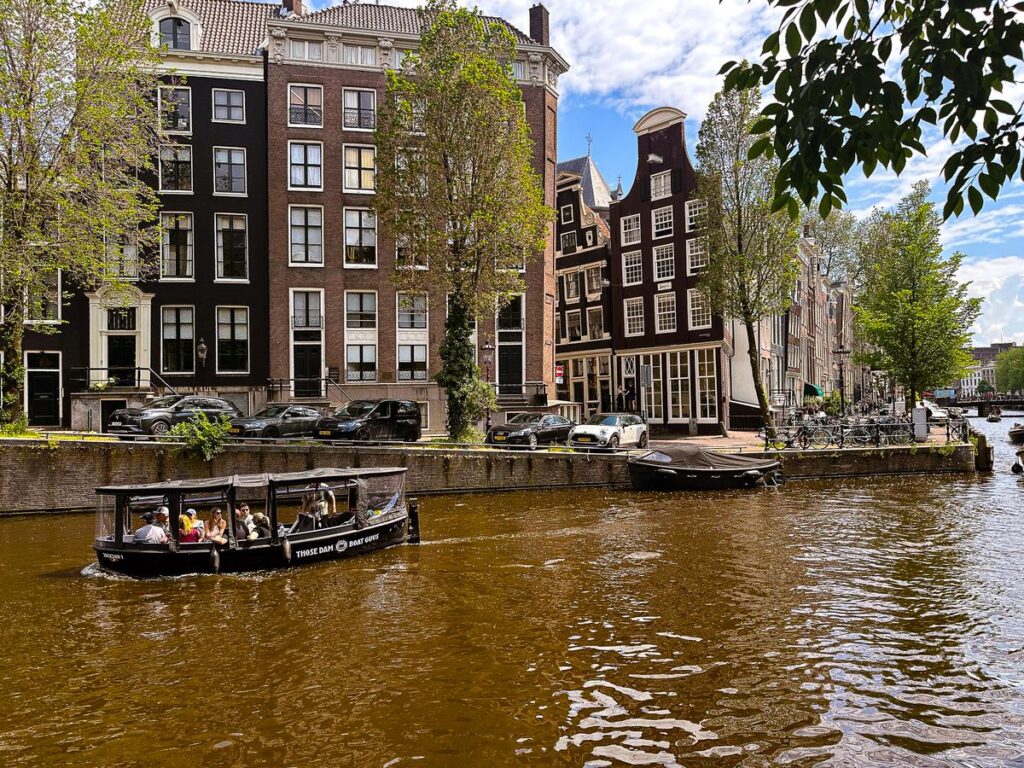
Walking along Amsterdam’s canals provides intimate views, and seeing the city from the water offers a different perspective. Canal cruises remain one of Amsterdam’s most popular tourist activities, with options ranging from large tour boats to intimate private vessels.
Types of Canal Cruises

- Classic Canal Tours: Large glass-topped boats offer 1-hour guided tours along the main canals with multilingual commentary. These affordable cruises (€15-20) provide a good overview of Amsterdam’s canal system and major landmarks.
- Evening/Candlelight Cruises: Experience Amsterdam’s illuminated bridges and buildings on an evening cruise. Some companies offer candlelight dinner cruises with food and wine for a romantic experience.
- Small Boat Experiences: For a more intimate experience, small electric boats holding 10-12 people allow access to narrower canals that larger vessels can’t navigate. Companies like Those Dam Boat Guys offer tours led by knowledgeable local guides.
- Self-Drive Boat Rental: Rent an electric boat and be your own captain. Companies like Mokumboot and Boaty offer rentals (no license required) for those who want the freedom to explore at their own pace.
- Specialized Theme Cruises: Several operators offer themed cruises focusing on architecture, history, cocktails, and cheese tastings. These specialty tours provide deeper insights into Amsterdam’s canal culture.
Popular Starting Points for Canal Cruises:

- Damrak (near Central Station)
- Rijksmuseum/Stadhouderskade
- Anne Frank House/Prinsengracht
- Amstel River boarding points
See Related: Amsterdam Travel Tips: Discover Hidden Gems and Local Secrets
Amsterdam Canal History: From Medieval Moats to UNESCO Status

Amsterdam’s relationship with water has defined the city since its beginnings as a small settlement on the banks of the Amstel River around 1250 CE. The evolution of its canal system tells the story of Amsterdam’s rise from fishing village to global trading power.
Medieval Origins (13th-16th centuries)

The earliest canals—including Oudezijds Voorburgwal and Nieuwezijds Voorburgwal—were originally natural waterways or dug as defensive moats around the medieval city. The Singel served as Amsterdam’s outer moat until the city outgrew its boundaries.
As Amsterdam grew in the 16th century, these defensive waterways gradually transformed into transportation routes for goods and people. The city’s layout was still organic and unplanned during this period.
The Golden Age Canal Ring (17th century)
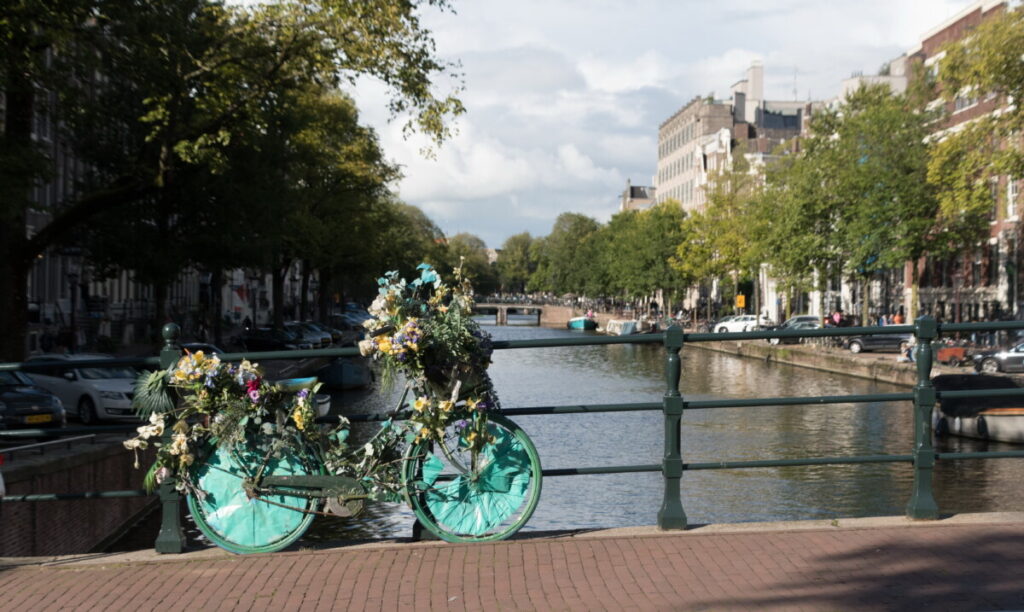
Amsterdam’s explosive growth during the Dutch Golden Age necessitated an ambitious expansion plan. In 1612, the city unveiled a comprehensive urban planning project: the grachtengordel (canal ring).
The three main canals—Herengracht, Keizersgracht, and Prinsengracht—were dug in concentric semicircles around the old city center. This wasn’t just an engineering marvel but also a real estate development project. Plots along the new canals were sold to wealthy merchants who built the grand houses we admire today.
This canal ring expansion represented revolutionary urban planning for its time, combining practical needs (transportation, water management, defense) with aesthetic and commercial considerations.
Industrial Era and Modernization (19th-20th centuries)
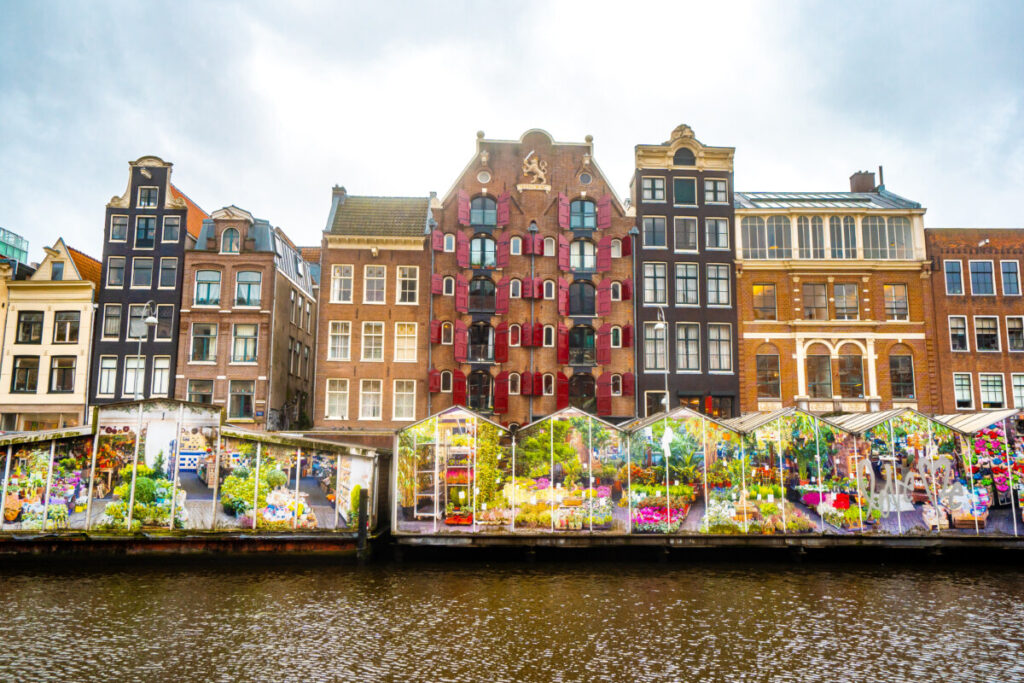
By the 19th century, many smaller canals were filled to create streets as wheeled transportation became more important. However, the major canals remained vital to Amsterdam’s identity and function.
The canals faced challenges during this period, including pollution, as they were both transportation routes and sewage disposal. Many houseboats appeared during housing shortages following World War II.
UNESCO Recognition and Modern Revival
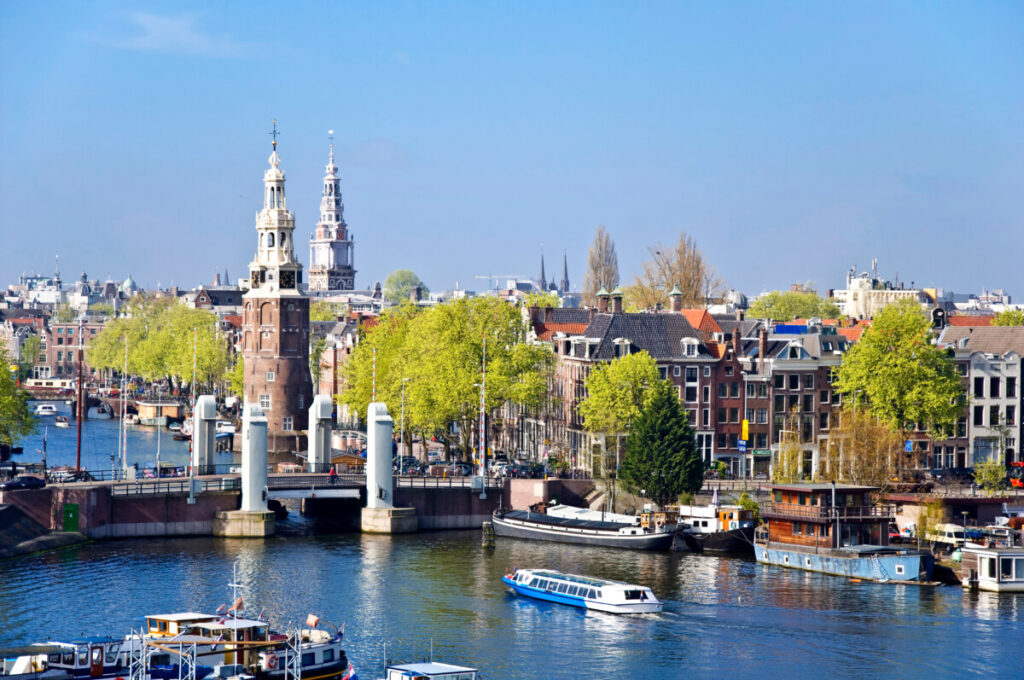
In 2010, Amsterdam’s canal ring was recognized as a UNESCO World Heritage site, acknowledging its “outstanding universal value” as a masterpiece of urban planning and a representation of the ideals of the Dutch Golden Age.
Today, the canals are cleaner than they’ve been in centuries. Water quality has improved significantly, with some fish species returning and occasional swimming events being held. The canal system remains central to Amsterdam’s identity, blending historical preservation with modern urban living.
Practical Information for Visiting Amsterdam’s Canals
Best Time to Visit
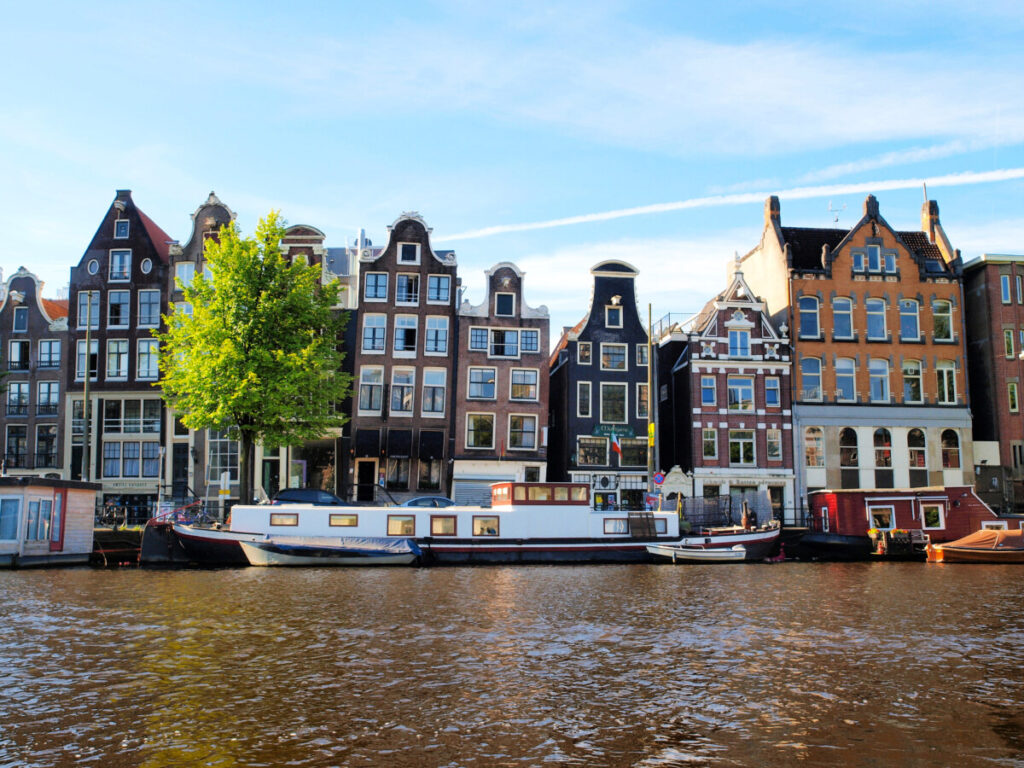
- Spring (April-May): Blooming trees line the canals, and tulip season transforms the city. King’s Day (April 27) brings citywide celebrations with many events centered around the canals.
- Summer (June-August): Warm temperatures make this the busiest tourist season. The Canal Pride parade (usually early August) fills the Prinsengracht with decorated boats and revelers.
- Autumn (September-October): Fewer crowds and beautiful foliage reflected in the canal waters make this a photographer’s dream.
- Winter (December-February): Magical holiday illuminations during Amsterdam Light Festival. On rare occasions when temperatures stay below freezing for several days, canals may freeze enough for skating.
Canal Tours and Transport

- Canal Cruises: Depart from multiple locations, with the highest concentration near Central Station. Booking in advance is recommended during peak tourist season.
- Canal Bus: Hop-on and hop-off services stop at major attractions along the waterways.
- Water Taxis: Available for point-to-point transfers, though more expensive than land alternatives.
Photography Tips

Golden Hour: Early morning and just before sunset offer the best light for canal photography, with fewer tourists and beautiful reflections.
Famous Viewpoints:
- Seven Bridges View on Reguliersgracht
- Brouwersgracht and Herengracht intersection
- Groenburgwal with Zuiderkerk tower
- Staalmeestersbrug bridge (the “Skinny Bridge”) over the Amstel
Seasonal Considerations: Spring brings flowering trees, while winter offers potential ice scenes and holiday illuminations.
Accessibility
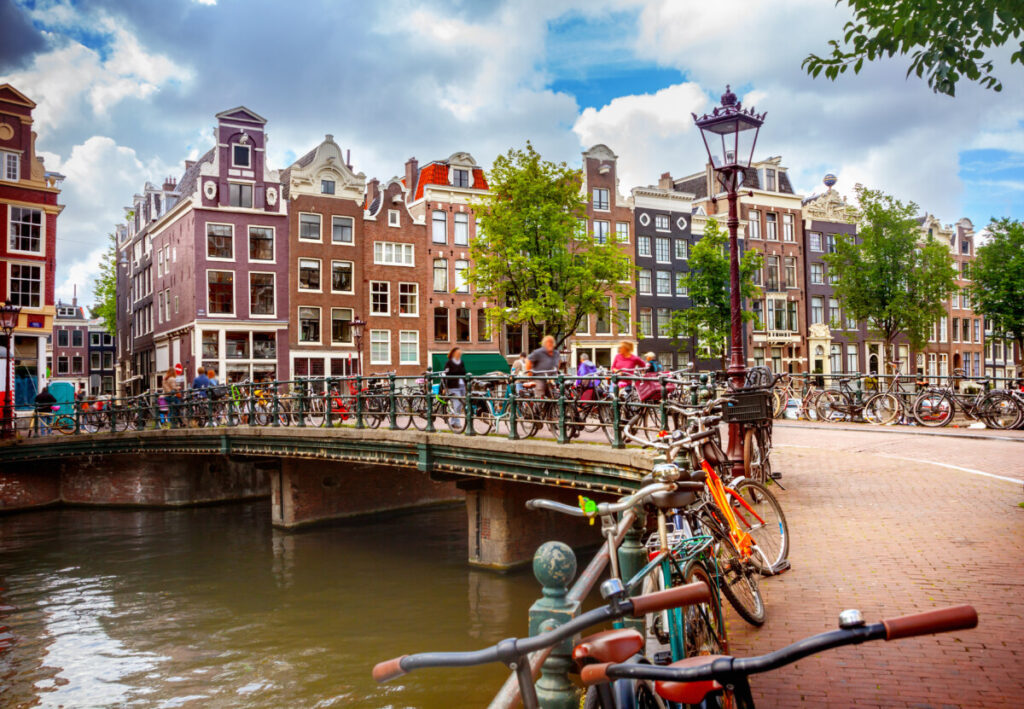
Most major canal paths are accessible, though some older bridges have steps. Canal tours vary in accessibility—larger commercial boats often have wheelchair access, while smaller private boats may not. Always check with the specific tour operator before booking.
Canal Etiquette

- Respect houseboats as private homes—don’t photograph residents or peer inside windows.
- Stay on designated paths and respect private property
- Use bridges to cross canals—swimming is generally not permitted
- Be aware of cyclists when walking along canal paths
Map of Amsterdam’s Canal System

To help you navigate Amsterdam’s complex waterways, reference this map highlighting the 15 iconic canals featured in this guide. The concentric pattern of the UNESCO-protected canal ring is visible, with Herengracht, Keizersgracht, and Prinsengracht forming the distinctive half-moon shape around the medieval center.
Exploring Amsterdam’s canals can be approached thematically:
- Historic Center Loop: Singel, Oudezijds Voorburgwal, Kloveniersburgwal, Groenburgwal
- Main Canal Ring: Herengracht, Keizersgracht, Prinsengracht
- Jordaan Exploration: Brouwersgracht, Bloemgracht, Egelantiersgracht
- Photography Route: Reguliersgracht (Seven Bridges), Groenburgwal, Brouwersgracht
- Cultural Heritage Path: Zwanenburgwal, Nieuwe Herengracht, Oudeschans
- Art Lover’s Walk: Spiegelgracht, Herengracht (Museum Van Loon), Keizersgracht (museums)
See Related: Historic Canal House Gable Stones You Shouldn’t Miss in Amsterdam
Frequently Asked Questions About Amsterdam’s Canals

During special events like the Amsterdam City Swim, the canals are temporarily open for swimming under supervised conditions.
How deep are Amsterdam’s canals?
The average depth of Amsterdam’s canals is 2-3 meters (6.5-10 feet). Regular dredging maintains these depths to accommodate boat traffic. The deepest sections can reach 4-5 meters (13-16 feet).
Can you swim in Amsterdam’s canals?
Swimming in Amsterdam’s canals is generally prohibited for safety and health reasons. However, water quality has improved significantly over recent decades. Special events like the Amsterdam City Swim occasionally allow swimming under supervised conditions. In the summer months, the Amstel River near the Amstel Hotel offers a designated swimming spot.
Are there fish in Amsterdam’s canals?
Yes, Amsterdam’s canals are home to a surprising variety of fish. Recent environmental improvements have led to increased biodiversity, with over 20 species now found in the canals, including pike, carp, eels, and even the occasional European catfish. The city regularly monitors fish populations as indicators of water quality.
How many canals and bridges does Amsterdam have?
Amsterdam has approximately 165 canals with a combined length of over 100 kilometers (60 miles). The city boasts about 1,500 bridges crossing these waterways, earning it the nickname “Venice of the North” (though Amsterdam actually has more canals than Venice).
Why are Amsterdam canal houses so narrow and tall?
Amsterdam’s distinctive narrow canal houses resulted from a tax system based on property width rather than overall size. Property taxes were once determined by the width of a house along the canal, prompting owners to build tall, narrow homes to minimize tax liability while maximizing living space. The characteristic large windows compensated for narrow interiors by providing ample natural light.
Do the canals ever freeze over?
Yes, though climate change has made this increasingly rare. When temperatures remain below freezing for several consecutive days, sections of Amsterdam’s canals can freeze solid enough for skating. The last significant “ice day” occurred in February 2021, when locals enjoyed skating on frozen canals for the first time in several years. When this happens, it becomes an impromptu city festival called “ijspret” (ice fun).
What are those hooks on top of Amsterdam buildings?
The large hooks or beams projecting from the gables of canal houses are hoisting beams (called “hijsbalken” in Dutch). Due to the narrow staircases in these tall, slim buildings, furniture and goods couldn’t be carried inside. Instead, items were hoisted externally using these beams and pulley systems and brought in through large windows. Many are still functional today and used when moving furniture.
How many houseboats are there in Amsterdam’s canals?
Approximately 2,500 houseboats line Amsterdam’s canals. These floating homes began appearing significantly after World War II during housing shortages. Today, they’re highly regulated and require permits, with waiting lists for mooring spots stretching for years. Many modern houseboats are sophisticated floating homes with utilities connected to the city’s infrastructure.
